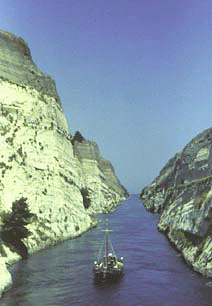Corinth, Then and Now
Your book talks about the Apostle Paul's work in the town of Corinth. Corinth is located on an isthmus—a narrow strip of land between the Aegean and Adriatic Seas. So in Paul's time, as it does today, this important harbor city teemed with travelers.
 Even then, it was obvious that Corinth would be a great location for a canal. The canal would save ships a lot of time.
Even then, it was obvious that Corinth would be a great location for a canal. The canal would save ships a lot of time.
Since there was no canal, ships were dragged out of the water and towed across the isthmus on a special carrier that ran on rollers along a limestone road. During the towing, the sailors from the ships spent their time in Corinth. This constant turnover of strangers shaped the city in two ways. First, some people who lived in Corinth became very rich selling supplies to all the visitors. Second, the city gained a reputation as an evil place where immorality was common.
When Paul wrote his letters to the Corinthians, he was concerned about both these issues. He was especially concerned that the wealthier people in the Christian community weren't sharing their food with those who had less—even at the Lord's Supper.
The canal was finally completed at the end of the nineteenth century. To be roomy enough for modern ships, it had to be 72 feet wide and 26 feet deep. At four miles long, it is the third largest canal in the world. Busloads of tourists stop to see it on their way between Athens and Corinth. As the tourists enjoy the fresh salty air, they remember Paul who sailed the Mediterranean world to bring the faith to Corinth and many other places.

